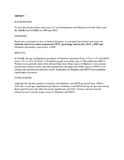| dc.description.abstract | BACKGROUND:
To describe the prevalence and causes of visual impairment and blindness in North Africa and the Middle East (NAME) in 1990 and 2010.
METHODS:
Based on a systematic review of medical literature, we examined prevalence and causes of moderate and severe vision impairment (MSVI; presenting visual acuity <6/18, ≥3/60) and blindness (presenting visual acuity <3/60).
RESULTS:
In NAME, the age-standardised prevalence of blindness decreased from 2.1% to 1.1% and MSVI from 7.1% to 4.5%. In 2010, 3.119 million people were blind, and 13.700 million had MSVI. Women were generally more often affected than men. Main causes of blindness were cataract, uncorrected refractive error, macular degeneration and glaucoma. Main causes of MSVI were cataract and uncorrected refractive errors. Proportions of blindness and MSVI from trachoma significantly decreased.
CONCLUSIONS:
Although the absolute numbers of people with blindness and MSVI increased from 1990 to 2010, the overall age-standardised prevalence of blindness and MSVI among all ages and among those aged 50 years and older decreased significantly (p<0.05). Cataract and uncorrected refractive error were the major causes of blindness and MSVI. | en_US |

